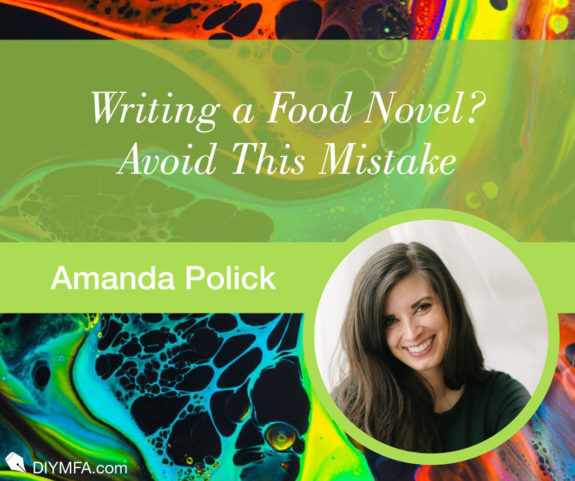No one sets out to make mistakes with their writing, especially a food novel. Writers are driven by a passion to share universal experiences, and sometimes, that’s exactly what gets them off-track.
It happens to the best of us.
Some professional nonfiction food writers have dipped their toes in the world of fiction to only sink. Sounds harsh, but writing about food is never writing about food, especially in fiction.
Just as The Office wasn’t about paper, all stories are about connection and what events mean for characters in their personal journeys. It’s easy to get swept away with what you think a story is about, but harder to dive into what’s underneath. Sometimes, you read a novel and know something is off, but you can’t quite pin it down. Chances are that there’s one thing likely happening, or not happening, in the story.
So if you’ve found yourself at a crossroads in your own work or want to learn from the mishaps of others, here’s the biggest mistake people make when writing a food novel, and how to fix it.
Focusing on the Food, but Missing the Real Story
Food is pretty seductive. People are endlessly fascinated by the behind-the-scenes of Michelin-starred restaurants, the lives of food writers and every other culinary-related job in-between. So a novel with even a hint of food in it will capture a reader’s attention immediately.
But that’s where most writers go wrong.
They throw in savory specialty shops, fine dining restaurants and maybe even a handful of recipes and expect it to carry the entire story. Some writers bury their story under hypnotic cadences and a sea of anecdotes, thinking that it’ll be enough. But a cool concept and pretty sentences does not a book make.
It’s also just the setting with food as the props. So readers get excited only to find themselves in lots of hip places bombarded with endless details with a story that goes nowhere. Your novel isn’t a montage, and while it can be fun for a bit, readers want to sink their teeth into something.
Why Writing a Food Novel is Tricky
Food is an intimidating topic to write about for a lot of writers, and they don’t want to look like amateurs. But if you study chefs, for example, they all have different methods and backgrounds. Some are passionate about recipes and the precision of their execution, while others lean into intuition and the mood of the day.
Food writing can cover a variety of topics, including restaurant reviews, cultural criticism and feature articles about the people and movements behind the scenes. Yes, you want to stretch your skills, but don’t pretend to know more than you do. Readers can feel when you’re adding details just because.
If you want to include something food-specific, but feel insecure about it, start researching and interviewing experts. You may use their knowledge, or it may serve as an invisible foundation for your characters. Regardless, the more you know, the easier it is to add tiny details throughout your story instead of a giant information dump that folks will probably skip.
Whatever your culinary background is, you can write about food and not be Samin Nosrat or Ruth Reichl. Promise.
How to Turn Your Story Around
After all of that, if you’re looking at your current pages and feel like you’ve buried your story with deliciously described smells and kitchen notes, don’t worry. You can turn your story around with a few tweaks.
Here are a handful of questions to ask yourself:
- What’s happening between the characters?
- How does the environment and surroundings influence their decisions and keep them from their goals?
- What does the food reveal about your characters and how they see the world?
- If they don’t get what they truly want, what will they lose?
Still not sure how this would show up in your own story?
Well, if you have a chef who has recently lost their job and is on a journey to finding themselves again, you have to dig into their internal struggle as well as their external one. Writing a food novel is more than tasty dish names and an occasional recipe. There has to be a transformation at the end of the novel or else, why are people buying the book in the first place?
Everything you introduce should have a purpose, or you’re just filling space. You can skip the elaborate descriptions of how people are working in the kitchen or how to cook the perfect roast chicken. That’s what cookbooks are for.
You can absolutely be detailed about a cooking method or specific dish, but it should be for a reason. Let’s say your main character adds milk to their scrambled eggs, even though they know it waters them down and makes them burn more quickly. But it’s how their mom cooked them growing up, and since she passed away six months ago, it makes her feel closer.
Food, like any other topic, is about connection and how we relate to the world. It’s easy to skip the story to get to the fun stuff, but you know deep down, there’s more to your book than that. When you dig into the meaning food has for your characters, you’ll tap into endless story possibilities and something worth your time to write.
Tell us in the comments: Have you ever experimented with writing about food, perhaps a food novel? How did it go?

Amanda Polick is a writer and book coach, who guides food folks through the writing process. Her work has been featured by Cooking Light, Food & Wine and Time. She lives in Nashville, Tennessee now, but a piece of her will be in California forever. To connect with Amanda, you can find her on her website.







